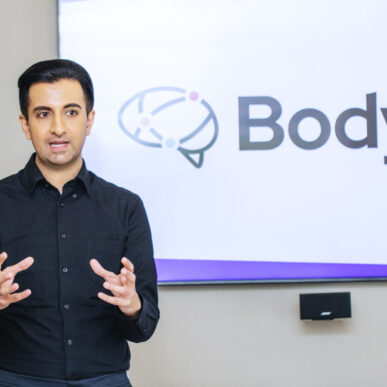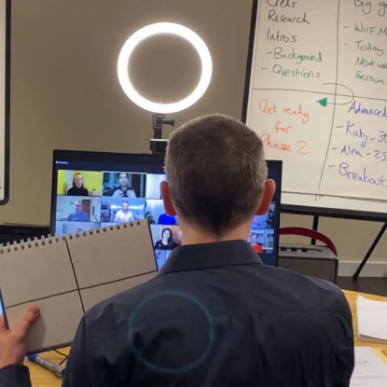Showing vulnerability in the workplace is the act of being able to let down our guard to allow people to fully connect with us and trust us. Being vulnerable at work means that you are exposed to the possibility of criticism, objections or failure.
These feelings are unpleasant, and over the course of a lifetime, we learn that being vulnerable and open causes us to hurt.
We may be bullied in school, picked on by siblings, punished for speaking up in class. We can fail at interviews, shut down by a difficult boss and learn to keep our ideas muted for fear of rejection.
This leads to building emotional armour to protect us from the pain of vulnerability at work. That armour becomes a burden though, as it prevents us from connecting with each other — and we desperately need to connect.
It’s only by dropping our armour that we can be true to ourselves. We can let people in, and allow them to fully connect with us, which is ultimately what we need to communicate effectively, build relationships or give a powerful presentation at work.
How your emotional armour is holding you back
A lot of people think that they are ‘naturally’ a poor speaker. They are too quiet, too timid, too introverted, too nervous to be a public speaker.
This is an example of emotional armour – and it is nonsense. In fact I believe this negative belief is the greatest barrier holding people back from communicating more effectively, stifling their ideas and damaging their ability to succeed.
When a baby is born it doesn’t politely murmur to the midwife, “Um, excuse me, I’m quite a quiet person, but if you can hear me could I please have some milk?”
Instead we all made our grand début screaming and wailing at a surprising volume compelling everyone around us to respond to our needs.
As we go through life, though, rejection and disappointment cause us to layer up our emotional armour and hide our vulnerability. This stifles our ability to speak in the way we were born to.
Is vulnerability important in the workplace?
Even though we may dislike the feeling of it, showing vulnerability in the workplace is an essential part of building trust and developing deeper relationships. The emotional armour that we put on stops us from showing this vulnerability.
Let’s take a look at two of the most common ways that we display our emotional armour – and how you can take it off.
1. Presenting horns when you have a halo
It takes people less than 15 seconds to make an emotional decision about you. Some studies have even shown that people can make accurate judgements of others in just 1/10 of a second. This opinion rarely changes, even twenty minutes later.
When you walk into a room, people take in your body language, your clothing, your hair, your vocal patterns. Then they decide whether or not they like you, trust you and want to work with you.
And the kicker is, if they subconsciously decide not to trust you, they’ll begin searching for a logical reason to back-up their emotion.
There’s a name for this. It’s called the horns or halo effect.
When you wear your emotional armour, people see you as having horns rather than a halo. In the first 15 seconds you may give an impression of something you’re not — guarded, grumpy or emotionless when in fact you’re pleasant and warm underneath.
If people’s first impression of you is a negative one, it can affect everything else that you do. Even if you give a trustworthy presentation, backed by reputable sources, and have character references that are pristine, if you come in guarded or closed off, your audience is going to find some reason to back up their initial negative impression.
They’ll give you horns when what you really have is a halo.
How to wear your halo
It’s essential that you take off your emotional armour before a meeting, not afterwards as many people do with a sigh of relief as they leave the room.
Think about doing what you can to build rapport with the people in the room through your body language, facial expressions, gestures and tone of voice. Being welcoming and open will help you to gain that halo from your audience.
2. Displaying armour through body language
It’s very common to see people displaying their emotional armour through their body language, and many people don’t even realise they’re doing it!
Putting on our emotional armour comforts us, as we feel safe and protected. This can include habits or physical behaviours that we do, often subconsciously, to make ourselves feel comfortable.
However, these habits can cause audiences to form a negative impression of us.
Think about it this way: wearing pyjamas makes you feel comfortable – but you would never wear them to work! It would give the wrong impression.
When people explain their behaviour at work as something they do to feel ‘comfortable’ they are often explaining actions they take to maintain their emotional armour in the workplace. These actions can appear as out of place as wearing pyjamas to the office.
Slumped body language when you’re giving a work presentation may feel comfortable but appear as if you don’t care, when really that’s just how you comfort your body when you’re nervous. Twisting your hands together when you talk could make you look shifty or untrustworthy — maybe unstable, depending. But actually, you’re just feeling insecure in the conversation you’re having with the CEO of the company.
How to take off your emotional armour
Taking off your emotional armour will allow you to show more vulnerability in the workplace and build those positive relationships.
Whatever your comforters are, it’s crucial to be aware of the impression they make. The next step is to become comfortable without those behaviours, as you return to the way you were born to speak, stand and move.
Think consciously about that first impression that you’ll make: ensure that you are standing tall and not slumped so that you look confident and engaged. Use open gestures with your palms up to welcome your audience and especially when facilitating questions or allowing others to speak.
Make eye contact with everyone in the room (or with the camera if you’re presenting remotely).
And of course, remember your facial expressions and smile.
Learn how to be more vulnerable in the workplace
One of the best ways to get rid of bad habits and to learn to be vulnerable in the workplace is to seek constructive feedback.
Getting critique from a professional will break you out of your comfort zone and help you realise all the strange ticks you’ve picked up wearing your emotional armour.
Feedback from your friends or family isn’t always helpful. They either know you too well or are too nice to give you advice in a constructive way. The same goes for your boss or co-workers — they aren’t all going to be pros at communication either.
A presentation skills workshop or communication course can build your self awareness and free you from old habits, but if you aren’t able to find one of those, then an acting class makes a good secondary option.
You’ll learn to drop your emotional armour in order to connect with strangers while performing — which is exactly what a good professional speaker does. And the classroom environment promotes critical feedback in a structured environment.
You’ll get actionable feedback you can use to improve while getting comfortable being the true version of yourself.
Get in touch
At Body Talk, we love helping our clients to feel more confident at showing vulnerability in the workplace and removing the armour that’s holding them back. Get in touch with us to find out about our courses, including one to one executive coaching.





















